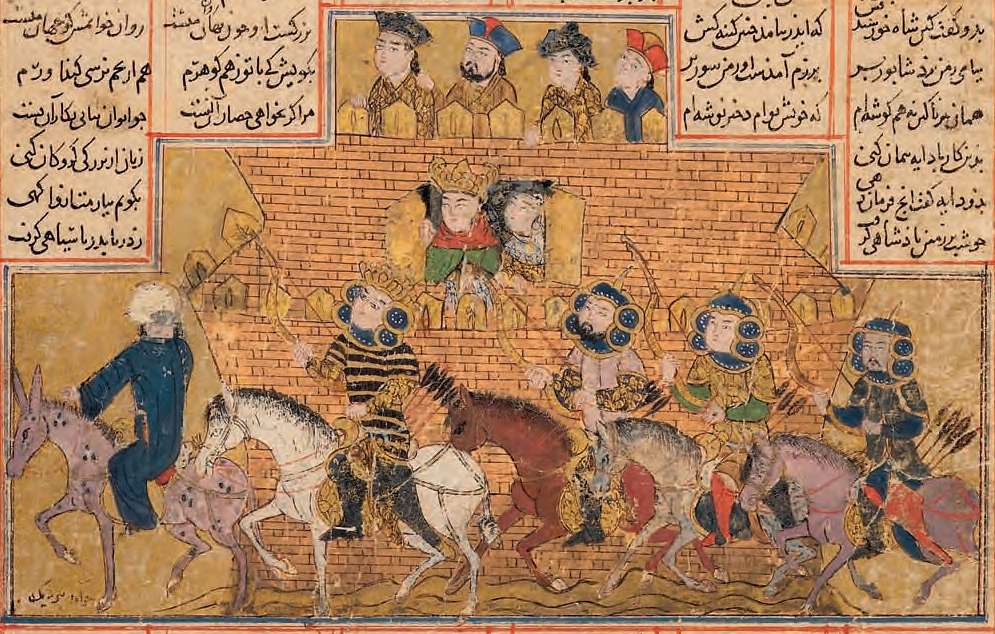Create an Amazon Business Account

Find the perfect fit with Amazon Prime. Try Before You Buy.
Ilkhanid Illustration
Shah Shapur besieges the fortress of the Arabian chieftain Taʾir in Yemen
Folio from the 'Second Small Shahnama' (Book of Kings) c.1300AD
Chapter 29 - Shapur Zul-aktaf (72 years)

Page from an Illustrated Manuscript of the 'Second Small Shahnama' of Firdawsi (d. 1020)
157 Shah Shapur besieges the fortress of the Arabian chieftain Taʾir in Yemen
Folio from the dispersed "Second Small Shahnama" manuscript
Tabriz or Baghdad, Ilkhanid, ca. 1300
Opaque water colour, gold and ink on paper
26.5 x 18.9 cm
Accession number: AKM 000017
Published: Welch 1972a, p. 49; Simpson 1979, p. 98; Canby 1998, p. 23
Boldly leading his troops, the youthful Shah Shapur of Iran rides out at dawn in black armour on a white horse, before the crenellated fortress in Yemen, where the Ghassanid Arab chieftain Ta'ir is besieged in retreat. Ta'ir and three courtiers watch with concern from the ramparts above. Ta'ir's beautiful daughter Malika and her nurse also look out from a fortress window: Malika is descended from Sasanian royalty, her mother having been abducted by Ta'ir from Ctesiphon years before. Here, the painter has indicated this Iranian bloodline by depicting Malika wearing a Sasanian-style crown. On seeing her cousin Shapur for the first time, the princess falls in love with him, and soon betrays her father (Davis 2006, 580-581).
The 'Small Shahnama' manuscripts are a group of four densely-illustrated copies of Firdawsi's Shahnama ("Book of Kings"). Without surviving colophons, no copy is dated, but three may be attributed to early fourteenth century Iran or Iraq, and the cultural orbit of the Mongol Ilkhanid dynasty. Although they are not necessarily royal commissions, they may indicate the Mongols' intended affiliations with Persian culture (Simpson 1979; Hillenbrand 2002, pp. 150-154; the fourth 'Small Shahnama' is in The Metropolitan Museum of Art, New York, and is attributed to Isfahan ca. 1330).
However fragmentary, these three are therefore the earliest known illustrated copies of Firdawsi's great epic poem. The detached folios of the so-called 'First' and 'Second' Small Shahnamas are dispersed in art collections around the world: this folio belongs to the latter manuscript. The codex and binding of the third is in the Freer Gallery, with many further folios also dispersed. The group has been closely analysed and studied by M.S. Simpson, where the original pagination and programme of illustration are carefully reconstructed for all three manuscripts (Simpson 1979; Simpson in: Hillenbrand 2004, pp. 9-24).
According to Simpson, each manuscript follows an individual series of paintings, and are not duplicates of one another, in spite of their obvious similarities in format and style. For example, the equivalent painting of Shapur in the 'First Small Shahnama' depicts the hero riding an elephant instead of a white horse (Dublin Chester Beatty Library Per106.54: Simpson 1979, p. 44, fig. 1).
Although significant, the 'Small Shahnama group' is not the earliest known illustrated works of narrative literature in the Islamic Middle East - other texts such as Ayyuqi's Warqa wa-Gulshah, Hariri's Maqamat, and Ibn al-Muqaffaʿ's Kalila wa-Dimna have survived in lively illustrated manuscripts from before 1300, as have other works of history and science, written in Arabic or Persian. The narrative complexity of Firdawsi's epic offered painters and patrons an unprecedented wealth of subject-matter, to which they responded with detailed illustrations of great panache. Stylistically, the 'Small Shahnama' paintings show an enduring pictorial tradition also related to late twelfth and thirteenth century paintings on ceramic, as well as the lively compositions and close horizontal formats of contemporary inlaid metalwork (Simpson 1985; Canby 1998, p. 22). Many features of the paintings are, however, definitely products of the new cultural environment of the Ilkhanids, such as the distinctive armour and helmets worn by Shapur and his forces.
Other folios from this dispersed manuscript are in the following museum collections: Aga Khan Trust for Culture (Geneva), British Museum (London), Brooklyn Museum of Art (New York), David Collection (Copenhagen), Freer Gallery (Washington DC), Cincinnati Art Museum, Museum of Fine Art (Montreal), McGill University Library (Montreal).
Moya Carey
Source: pp.204-205, Treasures of the Aga Khan Museum, Masterpieces of Islamic Art
Geneva, Aga Khan Trust for Culture
Title of Work: Shahnama (Second Small)
Manuscript: Ir.M. 1/A
Chapter 29 - Shapur Zul-aktaf (72 years)
Scene: Shapur besieges the city of the Arabian King Ta'ir
English Title: Shapur besieges the city of the Arabian King Tai
Dimensions (h x w): 74 x 119 mm
Format: Stepped within borders
Gregorian Date: 1300 (circa)
School: Baghdad
Source: Shahnama Project
Back to the 'Second Small Shahnama' (Book of Kings), Ilkhanid Persia, c.1300AD


